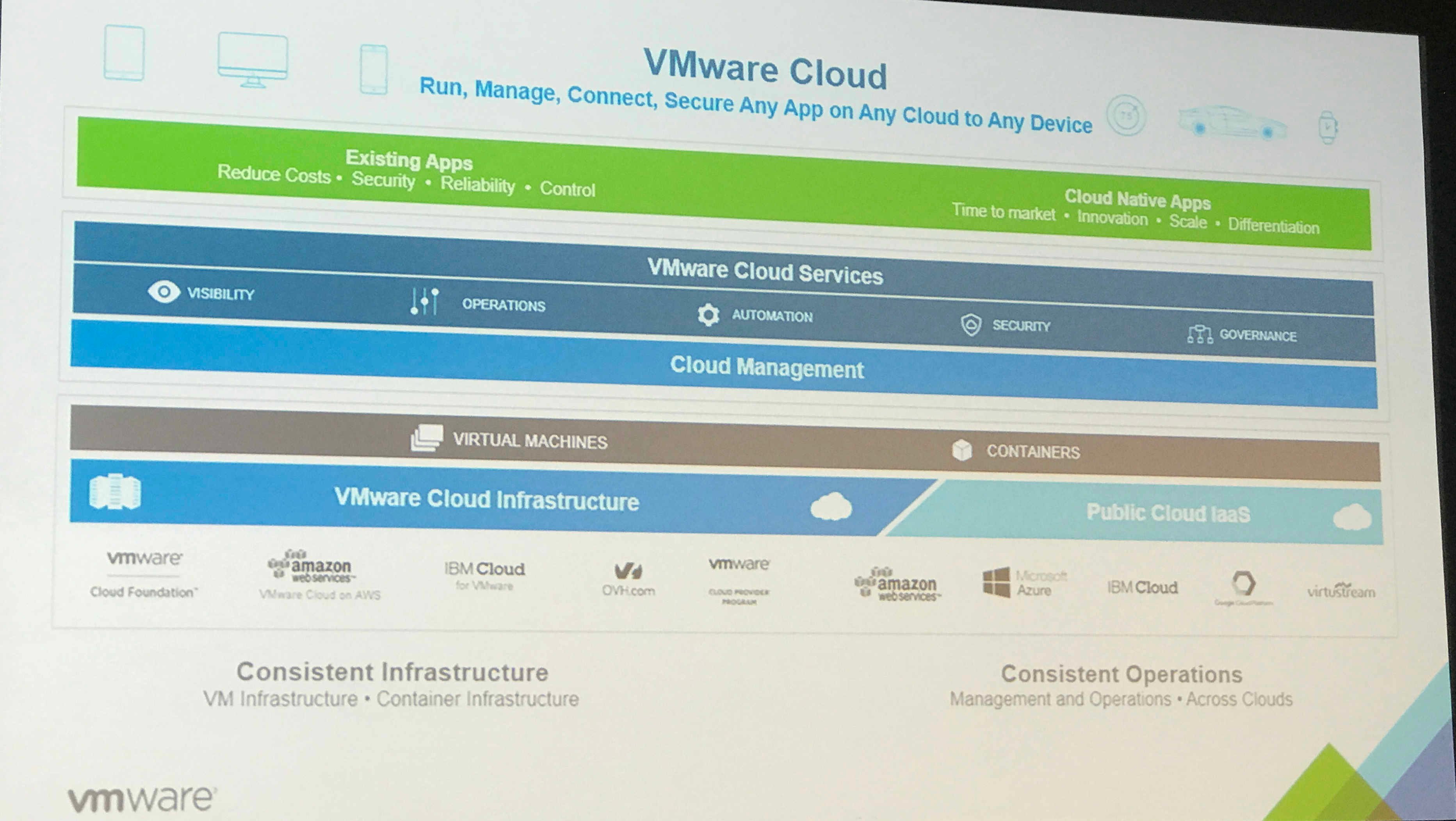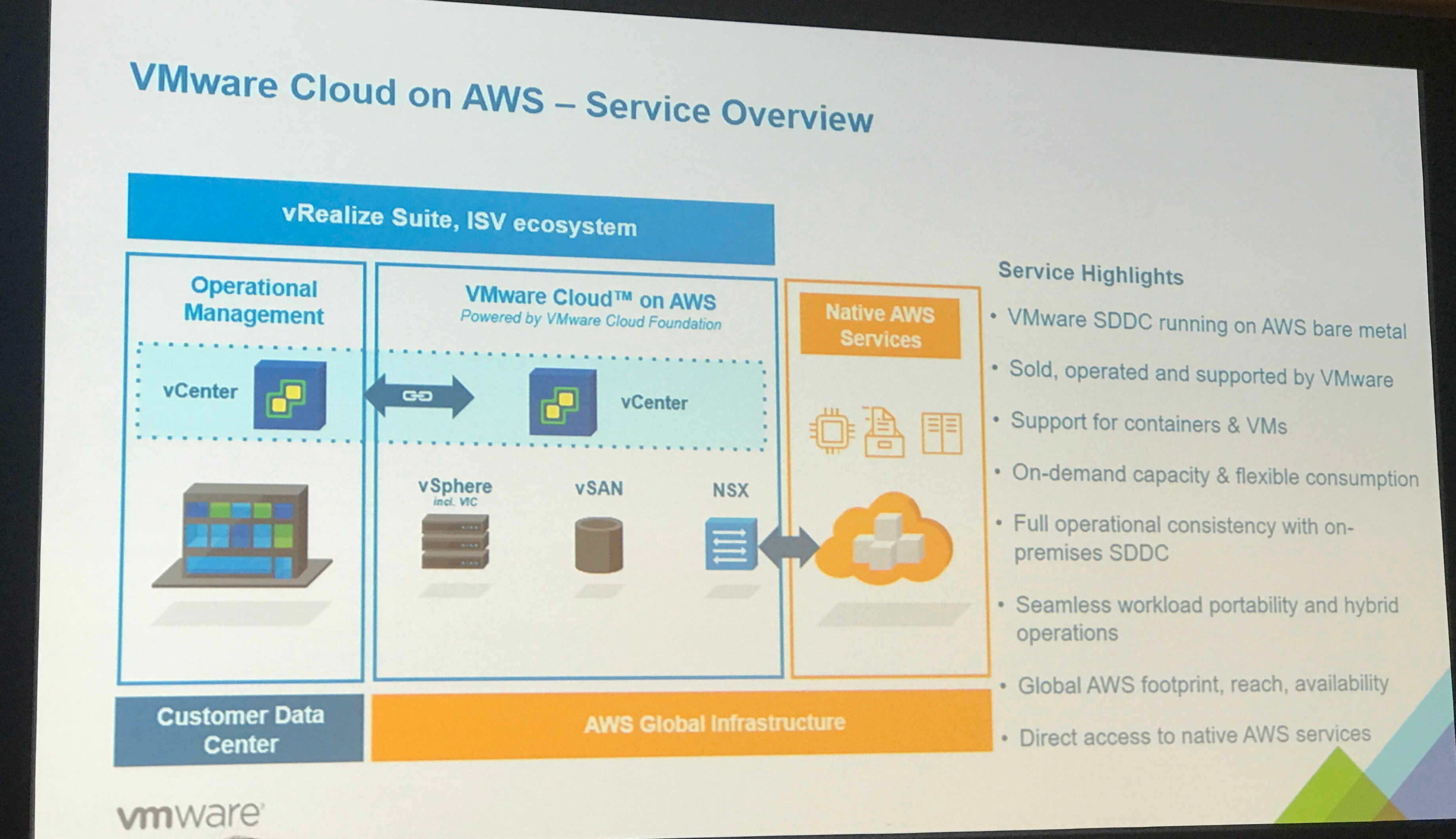At VMworld 2017, VMware announced the availability of VMware Cloud on AWS and of the six initial VMware Cloud Services. VMware Cloud on AWS offers customers the long expected capability of deploying VMware's Cloud Foundation Suite of SDDC products (vSphere, NSX and vSAN) to AWS. VMware Cloud Services enable operators, developers, security experts and compliance staff to consistently deploy and operate application infrastructure across today's most popular clouds: AWS, Google, Azure and vSphere. Today, both offerings, VMware Cloud on AWS and VMware Cloud Services are available from AWS U.S. West (Oregon Region), but can be used worldwide. VMware and Amazon are planning to roll out both offerings worldwide during 2018.
Answering the Key Questions on VMware on AWS Upfront
“VMware Cloud on AWS offers all the SDDC enterprise capabilities from VMware along with everything customers like about AWS.” This is how Mark Lohmeyer, VP Product at VMware sums up the value proposition of VMware and Amazon’s joint hybrid cloud offering. VMware on AWS is provisioned on “elastic bare metal.” This implies that VMware and Amazon created an infrastructure automation platform able to respond to ad-hoc requests for compute, storage and network resources managed by VMware’s three SDDC products: vSphere, vSAN and NSX. The service is sold, operated and supported by VMware, so that there is only one throat to choke. From an architectural perspective, the local instance of VMware vCenter connects to the vCenter instance on AWS. The joint environment can then be managed as one entity through VMware’s vRealize Suite or through other operations management and automation tools. Partner solutions for DevOps, migration, costing, network & security and Data Protection will all work on VMware Cloud on AWS.
Here is a collection of the most asked questions since last VMworld and their answers:
Question: When I move my applications to VMware on AWS, will there be additional networking charges for me to use AWS native services such as Lambda, RDS or Aurora?
Answer: The answer is “no." once the application runs on VMware on AWS, access to other AWS services will not incur any charges for data traffic.
Question: What will the network speed between VMware on AWS and other AWS services be like.
Answer: VMware and Amazon promise fast low-latency connections between VMware Cloud Services, VMware on AWS and native AWS services, as all of these elements are collocated in the same Amazon data centers.
Question: Which vSphere applications will run on VMware on AWS and which ones will not run?
Answer: All vSphere workloads will run the same way on AWS as they currently run in the corporate data center.
Question: How do I buy VMware on AWS resources?
Answer: Resources can be purchased on-demand or with a commitment of 3 or 5 years.
Question: Will containers work on VMware on AWS?
Answer: Yes, vSphere Integrated Containers (VIC) will work.
Introducing the Six VMware Cloud Services
The idea behind VMware Cloud Services is to provide a consistent operations management layer across public clouds and local data centers. This management layer aims to treat all infrastructure the same in terms of resource management, monitoring, root cause analysis, micro-segmentation and security. VMware's initial six Cloud Services are:
- Discovery: The discovery service provides an overview of application environments and their resource consumption by geography, business unit and team. Today the discovery service is based on tagging to keep track of dependencies.
- Cost Insight: This service aims to enable users to view and optimize their current operations cost across cloud and data centers. Customers can then compare cost between the supported clouds to further optimize their placement decision.
- Network Insight: Network Insight is based on the technology obtained through the Arkin acquisition from June 2016 and shows the data flows between applications across clouds. Users also receive an overview of security policies and micro segmentation.
- Wavefront: The Wavefront service enables cross-cloud real-time analytics of application and infrastructure metrics for monitoring, root cause analysis and infrastructure planning purposes.
- NSX Cloud: NSX cloud makes NSX software defined networking available as a service. This is significant as it enables customers to govern and control public cloud security in the same way they control data center security.
- AppDefense: AppDefense works on vSphere today and aims to secure application environments by identifying suspicious deviations in resource behavior.
In addition to these 6 new Cloud Services, VMware released the LogIQ service in beta mode. LogIQ offers log analytics as a service for trouble shooting and root cause analysis. Out of the box, LogIQ can be used for VMware’s suite of SDDC (vSphere, vSAN and NSX) products and it can receive data from the other VMware Cloud Services such as Discovery, Wavefront and Network Insight. LogIQ can be used in “simple” mode or with advanced machined learning added. VMware announced support for apps and infrastructure on AWS, Azure and Google Cloud. Users can create their standard queries and alerts through a visual frontend that enables browsing and auto completion within VMware’s SDDC object model.
Pricing
VMware Cloud Services are available as pay per use or commitment-based pricing models. The latter offer discounrts of 30% for a 1 year commitment and 50% for 3 years.





